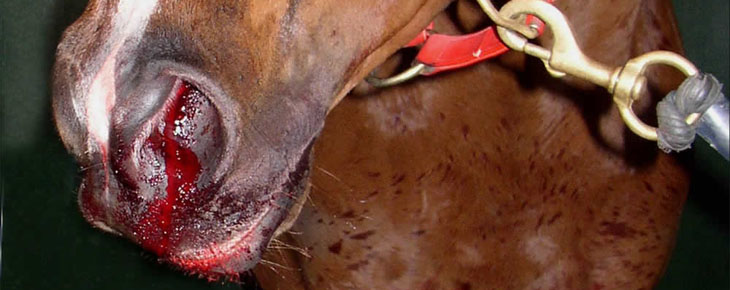
Exercise-Induced Pulmonary Hemorrhage (EIPH) is a condition observed in performance horses, particularly in racehorses. It is characterized by the presence of bleeding in the lungs during or after intense exercise. Horses affected by EIPH may exhibit epistaxis (nosebleeds) after racing or strenuous workouts.
Here are some key points about EIPH:
- Cause:
- The exact cause of EIPH is not fully understood, but it is believed to be related to the high pressures generated in the pulmonary blood vessels during intense exercise.
- The capillaries in the lungs can rupture due to increased pressure, leading to bleeding.
- Risk Factors:
- High-intensity exercise, such as racing or intense training, is a major risk factor for EIPH.
- Horses that engage in repeated strenuous exercise are more likely to develop EIPH.
- Age, genetics, and respiratory conditions may also contribute to the risk.
- Symptoms:
- Epistaxis (nosebleeds) is a common symptom observed in horses with EIPH.
- In some cases, horses may not exhibit external signs of bleeding, but the condition can be diagnosed through endoscopic examination of the airways.
- Diagnosis:
- EIPH is typically diagnosed through endoscopy, where a flexible tube with a camera is inserted through the horse’s nostrils to visualize the respiratory tract.
- Trainers and veterinarians may also monitor performance and look for signs of fatigue, decreased performance, or unusual respiratory noise.
- Prevention and Management:
- Several strategies are employed to manage and reduce the occurrence of EIPH, including adjusting training routines, providing adequate rest, and using medications.
- Lasix (furosemide) is a diuretic commonly used to reduce pulmonary congestion and bleeding. However, its use is a subject of debate and regulation in some racing jurisdictions.
- Regulations in Racing:
- In some racing jurisdictions, the use of medications like Lasix is regulated, and there are ongoing discussions about the impact of such medications on horse health and performance.
- Research and Treatment:
- Ongoing research is focused on understanding the underlying causes of EIPH and developing effective treatments.
- Treatment options may include medications and management changes, but there is no cure for EIPH.


Leave a Reply